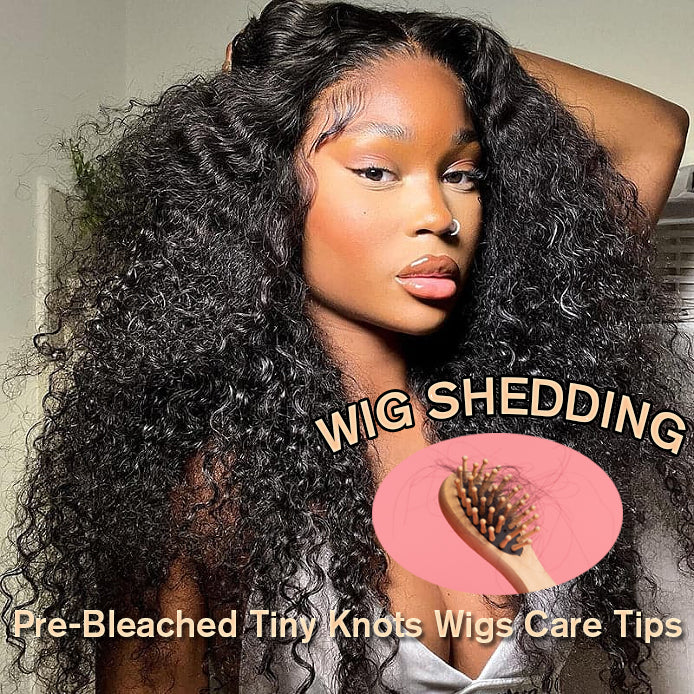
Wig Shedding:Pre-Bleached Tiny Knots Wigs Care Tips
For the majority of wig wearers, shedding is a common occurrence.Have you ever bought a pre-bleached tiny knots wig? In recent years, the demand for natural-looking wigs leading wig manufacturers to constantly innovate and improve their products. One significant advancement in wig craftsmanship is the achievement of pre-bleached knots. These knots play a crucial role in creating a realistic hairline, making wigs virtually indistinguishable from natural hair. However, these wigs sheds a lot when washing, pre-bleached wig look more natural but the wig knots are more fragile,and shed more. How to reduce shedding in tiny knots wigs?In today's article, we will explain the reasons behind your wig shedding and offer some preventive measures you can take to prolong the life of your wig.
What is the Pre-Bleached Tiny Knots Wig?

Bleached Knots
Bleaching knots is a technique that wig wearers and manufacturers use to make the wig knots less noticeable. The bleach lightens the knots and helps them to blend in with the lace cap and your skin. While some find bleaching knots to be difficult, once you get the hang of it, you’ll realize that it’s much easier to do than you thought.
A wig with bleached knots will look very natural right out of the package. The bleached knots will take on a color similar to your skin. So, when you put the wig on your head, it will look like the wig hair is growing from your scalp. That’s the main benefit of bleached knots.
On the other hand, bleached knots can make your knots weaker, and when your knots are weak, they become more prone to shedding.
Unbleached Knots
Unbleached wig knots are strong and resistant to shedding. If you leave your knots unbleached, you won’t have to worry about excessive shedding. But, at the same time, unbleached knots look like black dots and make your wig look unnatural.
Why Your Wig is Shedding

All wigs shed no matter what you do to them, and a little shedding is normal. But when you notice hair all over your counters, floors, and furniture, you’ve got a problem. A unit that’s shedding too much won’t last very long. Here are some of the reasons why your wig may be shedding more than usual:
You just got the wig
Sometimes, during wig processing, there are loose hairs left behind. So, when you get your unit home, you’ll notice a substantial amount of shedding. This type of shedding should only last up to a week. If shedding lasts for longer than that, something else could be to blame.
Rough handling
Wigs are vulnerable to shedding when they’re handled too roughly. To put things simply, the more you tug on your wig’s hairs, the more shedding you may experience.
Bleached knots
The lace portion of wigs is especially fragile, with loose hairs hand-tied to the lace base. Whenever these knots are bleached, they weaken, and the hairs shed.
Lack of nighttime protection
When you wear your wig to bed without protection, the hair rubs up against your pillow and covers, leading to tension and friction. This results in excessive shedding.
Using the wrong products on the wig
When you use harsh products on your wig, the hair begins to lose moisture and brittleness begins to set in. Shedding won’t be far behind.
How To Prevent Pre-Bleached Tiny Knots Wig From Shedding?
Don't Brush a Wig When It Is Wet
When combing a wet wig, hair loss is more likely to occur compared to combing dry wig, especially for pre-bleached glueless wear and go wigs. It is particularly important not to comb wet hair in this case, as the knots themselves are not as durable as unbleached knots wigs. Therefore, the correct method is to detangle your human hair wig when it is dry, before washing the wig. When blow-drying the wig, start by drying the roots from the inside of the cap, then you can begin to comb and style your wig. This approach can effectively reduce hair shed.

Comb Your Wig From Ends To Roots
If you’re used to combing your wig from roots to ends, this tip is for you. When you comb from roots to ends, you put unnecessary pressure and tension on the wig’s roots. You’re also more likely to rip through the hair strands. To minimize shedding, you should comb your wig from ends to roots instead of roots to ends. Combing from the ends allows you to gently remove knots as you move upwards toward the roots.
As you pull the comb through your hair, you should also hold the hair near the roots to keep it from being pulled.
Detangle Your Wig Regularly
Imagine when your human hair wig sheds the most? When you're detangling knots. The larger the knots, the harder they are to detangle, leading to hair shedding and breakage. That's why it's important to regularly comb your wig, clearing away small knots promptly. Don't wait for knots to become larger and then detangling, as it will take more time and result in wig falling off easily.

Away From The Heat
Heat can cause wig dry, dry hair tend to be more prone to tangle and shed. Therefore, blow dry your wig on a low heat or cooler setting. What’s more, style your human hair pre-bleached wig in a simple way, limited the frequent use of the curlers and the flat iron.
Protect Your Wig At Night
Protecting your wig at night can greatly reduce shedding. The best-case scenario is to take your wig off every night and place it on a mannequin head. But if you’d rather not take your wig off daily,Braid your wig down if it’s long or put on a silk scarf or bonnet.
Use Lightweight Products
There are tons of lightweight products on the market that work well and won’t leave your wig caked in grease and buildup. These are much better for your wig than heavy, oily products. Heavier products, like edge control and super hold gels are okay to use sparingly - just keep in mind that they can accelerate shedding.
Try Not to Scratch
Scratching your scalp through your lace can loosen up the wig’s knots and cause shedding. So, whenever your scalp itches, instead of scratching, gently pat your head. It may not give you quick relief, but it will take the edge off of the itch. If your scalp itchiness is severe, you should examine your scalp’s health and treat any underlying issues there. It could be scalp dryness or dandruff.
Keep Your Unit Moisturized
A dry wig is more likely to shed than a moisturized one, so it’s in your best interest to keep your wig hydrated. Wigs don’t get natural moisture from the scalp, so you’ve got to give your wig the oils it needs. Be sure to use lightweight oils like argan oil, coconut oil, or Moroccan oil.
In Conclusion
Pre-bleached tiny knots wig need higher maintenance and care for. Remember not to brush or comb it when wet, avoid pulling and extensive heat, using lightweight wig products, cleaning bulitup in time. By incorporating these tips into your wig care routine, you can significantly reduce shedding and keep your wig looking beautiful and natural.
Tags:
Previous
What Wigs For Glasses Wearers??-Simidola M-Cap Glueless Wig
Next
Stay Cool and Comfortable Wearing Wigs During Summer














